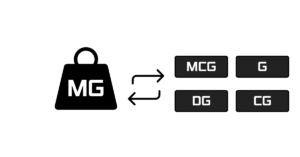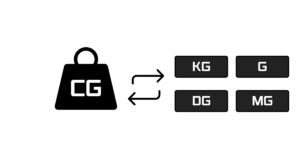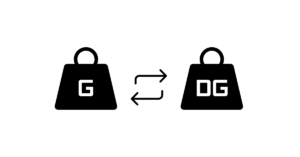Converting dg
The decigram (dg) is a metric unit of mass equal to 0.1 grams. While not commonly used in everyday measurements, understanding how to convert decigrams to other metric units is valuable in scientific fields, pharmaceuticals, and precise measurements. This guide will explore conversions between decigrams and other metric units, providing context and practical applications.
Decigrams to Kilograms (kg)
Conversion: 1 kg = 10,000 dg
Formula: kg = dg ÷ 10,000
The kilogram is the base unit of mass in the International System of Units (SI). It’s used for measuring larger masses such as body weight, bulk materials, and industrial quantities.
Example: 25,000 dg = 2.5 kg
Decigrams to Grams (g)
Conversion: 1 g = 10 dg
Formula: g = dg ÷ 10
Grams are the most commonly used unit for everyday measurements of small to medium masses, such as food ingredients or small objects.
Example: 350 dg = 35 g
Decigrams to Centigrams (cg)
Conversion: 1 cg = 0.1 dg
Formula: cg = dg × 10
Centigrams are often used in precise chemical measurements or for very small objects.
Example: 7.5 dg = 75 cg
Decigrams to Milligrams (mg)
Conversion: 1 mg = 0.01 dg
Formula: mg = dg × 100
Milligrams are frequently used in pharmaceuticals, nutrition labels, and chemistry for measuring very small quantities of substances.
Example: 0.5 dg = 50 mg
Practical Applications:
Chemistry: In chemical experiments, precise measurements are crucial. Converting between different units allows scientists to work with the most appropriate scale for each substance or reaction.
Pharmaceuticals: Drug dosages are often measured in milligrams or micrograms. Understanding unit conversions is essential for accurate medication administration.
Nutrition: Food labels often list ingredients in grams or milligrams. Being able to convert between units helps in understanding nutritional content and portion sizes.
Manufacturing: In industries producing small components or working with precise measurements, the ability to convert between units ensures accuracy in production and quality control.
Educational purposes: Teaching metric conversions helps students develop a strong foundation in mathematics and scientific measurement.
Tips for Accurate Conversions:
Always double-check your calculations, especially when dealing with very large or small numbers.
Use a calculator for complex conversions to minimize errors.
Remember the metric prefixes: kilo- (1000), centi- (1/100), milli- (1/1000), etc.
Practice with real-world examples to better understand the scale of different units.
While decigrams are not as commonly used as other metric units, understanding how to convert them provides a more comprehensive grasp of the metric system. This knowledge is particularly valuable in scientific fields, where precision is paramount. By mastering these conversions, you’ll be better equipped to handle a wide range of measurement scenarios, from everyday cooking to complex laboratory work.
Decigram Conversion: Essential Factors and Applications
Conversion Factors:
1 decigram (dg) equals:
0.0001 kilograms (kg)
0.1 grams (g)
10 centigrams (cg)
100 milligrams (mg)
These factors stem from the metric system’s base-10 structure.
Importance in Various Fields:
Pharmaceuticals:
Precise measurements are critical for medication safety and efficacy. Pharmacists often convert between decigrams and milligrams for accurate dosing.
Chemical Research:
Laboratories rely on exact measurements for experiments. Converting between decigrams and other units ensures precise substance mixing and reaction analysis.
Nutrition Science:
Accurate measurement of food components and supplements is crucial. Conversions help nutritionists calculate nutrient intake and develop dietary plans.
Culinary Arts:
Recipe accuracy often requires converting between units. Understanding decigram conversions helps achieve desired culinary results.
Practical Conversion Examples:
15 dg to kg: 15 × 0.0001 = 0.0015 kg
25 dg to g: 25 × 0.1 = 2.5 g
30 dg to cg: 30 × 10 = 300 cg
40 dg to mg: 40 × 100 = 4000 mg
Tips for Accurate Conversions:
Use a calculator for complex calculations
Double-check your work, especially with large numbers
Always include units in your final answer
Practice regularly to improve speed and accuracy
Understanding decigram conversions enhances precision in scientific, medical, and everyday applications. While decigrams are less common in daily life, mastering these conversions provides a solid foundation for working with the metric system across various fields.
Remember: In fields requiring high precision, even small conversion errors can have significant consequences. Always verify your calculations and use reliable tools when accuracy is paramount.
Applications of Decigram Conversion Across Fields
Chemistry and Laboratory Work
In chemical labs, precise measurements are crucial for:
Preparing solutions
Analyzing substances
Conducting experiments
Accurate decigram conversions ensure:
Correct reagent quantities
Reliable experimental results
Valid scientific conclusions
Pharmaceutical Industry
Pharmacists and manufacturers rely on exact measurements for:
Medication preparation
Dosage formulation
Precise decigram to milligram conversions help:
Ensure patient safety
Maintain treatment efficacy
Comply with regulatory standards
Nutrition and Dietetics
Nutritionists use accurate measurements to:
Assess nutrient intake
Develop dietary plans
Monitor nutritional status
Converting decigrams supports:
Accurate food component analysis
Precise supplement dosing
Personalized dietary recommendations
Education
Teachers use metric conversions to:
Explain the metric system
Demonstrate real-world applications
Enhance problem-solving skills
Students benefit by:
Understanding unit relationships
Improving calculation abilities
Preparing for scientific careers
Culinary Arts
Chefs and home cooks use conversions for:
Following recipes accurately
Scaling ingredients
Achieving consistent results
Precise measurements help in:
Baking, where ratios are critical
Creating balanced flavors
Reproducing dishes reliably
Conclusion:
Mastering decigram conversions is essential across various fields. It ensures:
Accuracy in scientific research
Safety in pharmaceutical applications
Precision in nutritional planning
Effectiveness in education
Consistency in culinary arts
By understanding these conversions, professionals and enthusiasts alike can:
Perform tasks with greater precision
Make informed decisions
Contribute to advancements in their respective fields
Whether in a lab, pharmacy, kitchen, or classroom, the ability to convert decigrams accurately is a fundamental skill that supports reliability, safety, and innovation.







